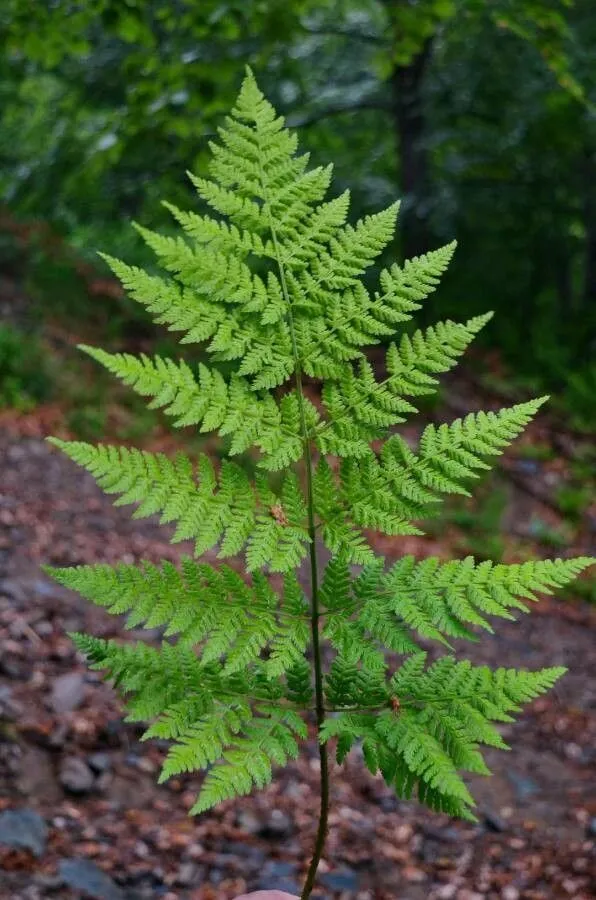
Author: (C.Presl) Fraser-Jenk. & Jermy
Bibliography: Fern Gaz. 11: 338 (1977)
Year: 1977
Status: accepted
Rank: species
Genus: Dryopteris
Vegetable: False
Observations: Subarctic & Temp. Northern Hemisphere
The Northern buckler fern, scientifically named Dryopteris expansa, is a striking species of fern belonging to the Polypodiaceae family. Described by botanists Charles Presl, Fraser-Jenkins, and Jermy in the Fern Gazette in 1977, this fern is known for its adaptability to various environments within the subarctic and temperate regions of the Northern Hemisphere.
With a lush, green appearance, Dryopteris expansa thrives in a variety of moist, shaded habitats, including forest floors and damp, rocky areas. It has finely divided fronds that give it a delicate, lace-like texture, extending elegantly from a central base. This fern’s fronds can reach substantial lengths, creating a visually appealing spread that can cover significant ground.
Staying true to its name, the Northern buckler fern is particularly hardy, withstanding colder temperatures and thriving in regions where many other fern species may not survive. Its ability to adapt makes it a resilient component of its native ecosystems, contributing to the biodiversity and ecological health of the areas it inhabits.
The Northern buckler fern plays an essential role in its habitat, providing cover and contributing to the forest’s understory diversity. Its presence supports a variety of ground-dwelling fauna and flora, creating a more balanced and rich ecosystem. For botanists and horticulturists alike, Dryopteris expansa is an object of interest, not only because of its aesthetic appeal but also due to its ecological significance and resilience in challenging environments.
As an enduring symbol of the Northern Hemisphere’s flora, Dryopteris expansa continues to capture the interest of plant enthusiasts and researchers, offering insights into the complex interactions and adaptability of plant species within often harsh subarctic and temperate climates.
Deu: feingliedriger dornfarn, feingliedriger wurmfarn
Dan: finbladet mangeløv
Eng: northern buckler fern, northern wood fern, spread wood fern, spreading woodfern, northern buckler-fern, spreading wood fern, broad buckler fern, broad spinulose shield fern, spiny wood fern
Swe: isoalvejuuri, nordbräken, nordlig lundbräken
Fin: isoalvejuuri
Nob: sauetelg
Nno: sauetelg
Nld: tere stekelvaren
Fra: dryoptère dressée, dryoptère étalée, dryoptéris élargi, dryoptéris étalé
Sme: sávzzagáiski
Cym: marchredyn y gogledd, marchredynen y gogledd
En: Northern buckler fern, Northern wood fern, Spread wood fern, Spreading woodfern, Spreading wood fern, Northern Buckler-fern, Broad buckler fern, Broad spinulose shield fern, Spiny wood fern
Da: Finbladet mangeløv
Nl: Tere stekelvaren
Fi: Isoalvejuuri
Fr: Dryoptéris dilaté, Fougère dilatée, Dryoptéris étalé, Dryoptéris élargi, Dryoptère dressée, Dryoptère étalée
De: Feingliedriger Dornfarn, Feingliedriger Wurmfarn
Se: Sávzzagáiski
Nb: Sauetelg
Nn: Sauetelg
Sv: Isoalvejuuri, Nordbräken, Nordlig lundbräken
Cy: Marchredyn y Gogledd, Marchredynen y Gogledd
© copyright of the Board of Trustees of the Royal Botanic Gardens, Kew.
© copyright of the Board of Trustees of the Royal Botanic Gardens, Kew.
© copyright of the Board of Trustees of the Royal Botanic Gardens, Kew.
Taken May 24, 2022 by Andrej Rozman (cc-by-sa)
Taken Feb 8, 2022 by Tom Foolery (cc-by-sa)
Taken May 24, 2022 by Andrej Rozman (cc-by-sa)
Taken Dec 25, 2021 by offline ad (cc-by-sa)
Taken Dec 25, 2021 by offline ad (cc-by-sa)
Taken Feb 8, 2022 by Tom Foolery (cc-by-sa)
Growth habit: Forb/herb
Ph maximum: 5.0
Ph minimum: 4.5
Light: 3
Atmospheric humidity: 7
Soil nutriments: 3
Family: Myrtaceae Author: (F.Muell.) K.D.Hill & L.A.S.Johnson Bibliography: Telopea 6: 402 (1995) Year: 1995 Status:…
Family: Rubiaceae Author: Pierre ex A.Froehner Bibliography: Notizbl. Bot. Gart. Berlin-Dahlem 1: 237 (1897) Year:…
Family: Sapindaceae Author: Koidz. Bibliography: J. Coll. Sci. Imp. Univ. Tokyo 32(1): 38 (1911) Year:…
Family: Asteraceae Author: A.Gray Bibliography: Pacif. Railr. Rep.: 107 (1857) Year: 1857 Status: accepted Rank:…
Family: Fabaceae Author: Medik. Bibliography: Vorles. Churpfälz. Phys.-Ökon. Ges. 2: 398 (1787) Year: 1787 Status:…
Family: Aspleniaceae Author: (Cav.) Alston Bibliography: Bull. Misc. Inform. Kew 1932: 309 (1932) Year: 1932…